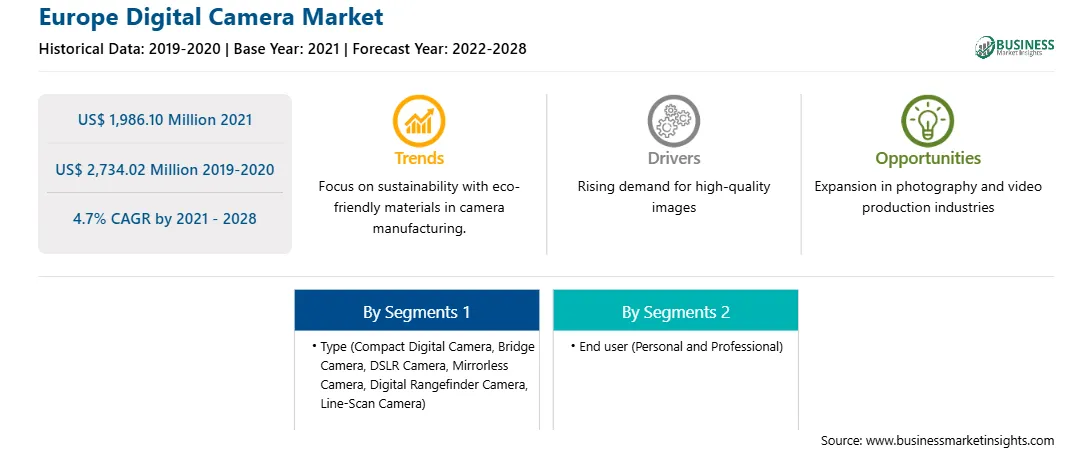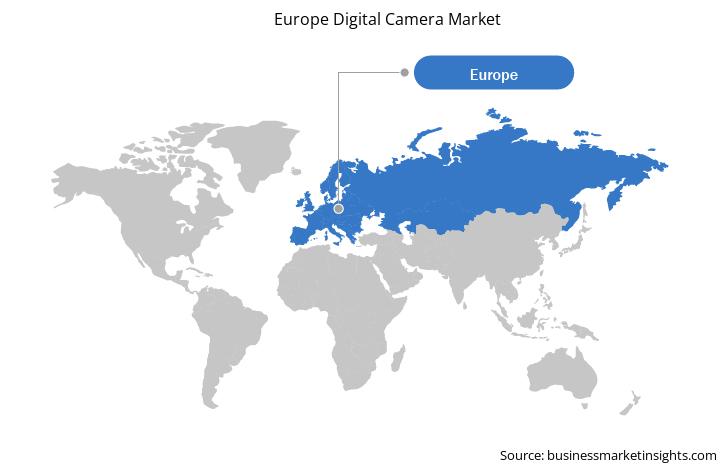The European digital camera market is further segmented into Germany, France, the UK, Italy, Russia, and the Rest of Europe. The Rest of Europe includes countries such as Spain, the Netherlands, Turkey, Switzerland, Poland, Sweden, Belgium, and Norway. Europe is one of the most popular destinations for travelers and travel photography. Many tourists travel to Europe with high-end cameras to capture beautiful memories. With the capacity to edit photographs and share them with others using platforms such as the internet, Facebook, YouTube, Myspace, and blogs, photography has taken on a new dimension in the digital age. Compact digital cameras are the most basic cameras and are used for everyday tasks. They are small enough to fit in a pocket or a tiny purse. These cameras are widely popular as they are easy to carry and to use, as well as sturdy, and less expensive than other cameras. Furthermore, rapid changes in the entertainment and media sector, as well as enhanced customer experience, has brought rapid changes in technology, business structures, and consumer behavior. Further, the rising per capita income and surging awareness about technological advancements among the population in several European countries are complementing the expansion of the digital camera market. Many big manufacturers are working on compact cameras that can take high-resolution photos
In Europe, currently the UK and Russia are the hardest-hit countries by the coronavirus pandemic. It is estimated to suffer an economic hit due to a lack of revenue from various industries, as the country recorded the highest number of coronavirus cases followed by France, Spain, Italy, and Germany. Other member states have implemented drastic measures and travel restrictions, including partially closing their borders. The government in various countries like Italy and Spain had imposed complete lockdown in various areas for multiple weeks, which affected the business activities in these countries. Businesses in the above-mentioned countries either had to suspend their operations or reduce their activities in a substantial manner which resulted in supply and demand disruptions and thus affected the sales of companies operating in the region. As the region has abundant tourist and heritage places for individuals to plan their trips and capture beautiful memories with the help of these high-end camera, the growth prospective of digital cameras is broad in this region, however, as the cases in various European countries are high, the growth of digital cameras might get disrupted in 2020.

Strategic insights for the Europe Digital Camera provides data-driven analysis of the industry landscape, including current trends, key players, and regional nuances. These insights offer actionable recommendations, enabling readers to differentiate themselves from competitors by identifying untapped segments or developing unique value propositions. Leveraging data analytics, these insights help industry players anticipate the market shifts, whether investors, manufacturers, or other stakeholders. A future-oriented perspective is essential, helping stakeholders anticipate market shifts and position themselves for long-term success in this dynamic region. Ultimately, effective strategic insights empower readers to make informed decisions that drive profitability and achieve their business objectives within the market.

| Report Attribute | Details |
|---|---|
| Market size in 2021 | US$ 1,986.10 Million |
| Market Size by 2028 | US$ 2,734.02 Million |
| Global CAGR (2021 - 2028) | 4.7% |
| Historical Data | 2019-2020 |
| Forecast period | 2022-2028 |
| Segments Covered |
By Type
|
| Regions and Countries Covered | Europe
|
| Market leaders and key company profiles |
The geographic scope of the Europe Digital Camera refers to the specific areas in which a business operates and competes. Understanding local distinctions, such as diverse consumer preferences (e.g., demand for specific plug types or battery backup durations), varying economic conditions, and regulatory environments, is crucial for tailoring strategies to specific markets. Businesses can expand their reach by identifying underserved areas or adapting their offerings to meet local demands. A clear market focus allows for more effective resource allocation, targeted marketing campaigns, and better positioning against local competitors, ultimately driving growth in those targeted areas.

The digital camera market in Europe is expected to grow from US$ 1,986.10 million in 2021 to US$ 2,734.02 million by 2028; it is estimated to grow at a CAGR of 4.7% from 2021 to 2028. Growing demand for mirrorless cameras; A mirrorless system camera does not involve a mirror box within its body and are designed with a compact and attractive exterior with an electronic viewfinder paired with interchangeable lens. Such cameras offer convenience in use compared to digital SLR cameras owing to their smaller and lighter structure. Mirrorless camera comprises lens at the front body along with sensor placed inside and a screen along with an optional viewfinder placed at the back. Additionally, such cameras have small, short, and light lenses and are constructed with a tiny LED or OLED screen, which helps to deliver best possible results altogether. Despite their smaller size, such cameras are designed to provide high quality images with outstanding clarity as that of other conventional digital cameras. The limited presence of glass elements within lenses allows quick autofocus. Further, mirrorless cameras are generally composed of APS-C sensor or a Micro Four Thirds sensor, which offers portability and convenience over DSLRs. With the rising adoption of mirrorless cameras, there is increase in variety of lenses and their respective configurations. Such cameras are extensively demanded from budding photographers to various professional photographers owing to compact and sleekier mirrorless designs along with limited noise making. This is bolstering the growth of the digital camera market.
In terms of type, the digital single lens reflex (DSLR) segment accounted for the largest share of the Europe digital camera market in 2020. In terms of end user type, the professional
A few major primary and secondary sources referred to for preparing this report on the digital camera market in Europe are company websites, annual reports, financial reports, national government documents, and statistical database, among others. Major companies listed in the report are Canon Inc
The Europe Digital Camera Market is valued at US$ 1,986.10 Million in 2021, it is projected to reach US$ 2,734.02 Million by 2028.
As per our report Europe Digital Camera Market, the market size is valued at US$ 1,986.10 Million in 2021, projecting it to reach US$ 2,734.02 Million by 2028. This translates to a CAGR of approximately 4.7% during the forecast period.
The Europe Digital Camera Market report typically cover these key segments-
The historic period, base year, and forecast period can vary slightly depending on the specific market research report. However, for the Europe Digital Camera Market report:
The Europe Digital Camera Market is populated by several key players, each contributing to its growth and innovation. Some of the major players include:
The Europe Digital Camera Market report is valuable for diverse stakeholders, including:
Essentially, anyone involved in or considering involvement in the Europe Digital Camera Market value chain can benefit from the information contained in a comprehensive market report.